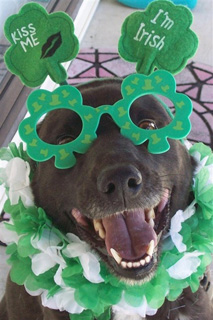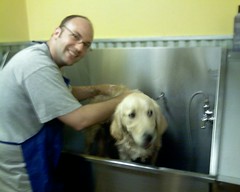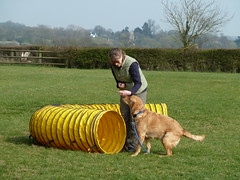Here is an excellent article from the University of Illinois College of Veterinary Medicine on what to do about a pets joint pain by Sarah Netherton
“Orthopedic pain is considered a severe type of pain that any mammal can experience,” asserts Dr. Ashley Mitek, a veterinarian who is completing an internship in small animal medicine and surgery at the University of Illinois College of Veterinary Medicine in Urbana. And anyone who has broken their arm or torn their ACL would probably agree.
In pets, acute orthopedic pain can be caused by a traumatic injury, such as being hit by a car or a tear in the cranial cruciate ligament—the equivalent in human medicine being the dreaded “ACL tear.” Orthopedic pain can also occur from a surgical procedure such as limb amputation or fracture repair.
If pain is left untreated, systemic problems can develop, such as increased heart rate and blood pressure and decreased wound healing and immune function. It’s also important to note that, “the longer pain goes untreated, the greater the risk that the animal may develop chronic pain, which can be difficult to manage,” says Dr. Mitek.
With limb fractures, a veterinarian may try to immobilize the fracture with a padded bandage if possible, but the animal should also receive pain medication while waiting for surgical correction or casting. One technique that can be used to provide analgesia for hind limb surgeries is an epidural, a procedure that is similar to the procedure used to alleviate pain during childbirth.
“Epidurals have a low risk of adverse side effects, and a combination of morphine (a narcotic) and a local anesthetic can provide pain relief for 12 to 24 hours,” explains Dr. Mitek. “Epidurals work by limiting pain signal transmission in the central nervous system—the spinal cord and brain—to parts of the brain that recognize pain. A single epidural can be administered prior to surgery or a catheter can be placed to facilitate repeated epidurals to prolong the pain relief for several days.”
If your dog receives an epidural for pain control, you might be surprised to see a small shaved spot where the epidural was administered. Dr. Mitek says not to worry, because the hair usually grows back within a few months – though it can take longer in some breeds, and on rare occasions, grow back as a slightly different color than the surrounding hair.
Pain relief techniques for front limb orthopedic pain can sometimes be a bit more difficult. This depends on the location of the injury or the surgical procedure that is to be performed. Some options include a brachial plexus block, which provides pain relief from the elbow to the tip of the foot, or a ring block that provides pain relief specific to the paw and toes.
Any time a nerve is damaged, whether from trauma or as part of surgery, animals can develop neuropathic or “wind up” pain. This results in the animal becoming more sensitive to pain and could lead to a condition known as allodynia, feeling pain from a stimulus that ordinarily does not cause pain, such as the wind blowing across your face; or hyperalgesia, an increased sensitivity to pain. Aggressive pain management can be implemented to avoid this outcome.
“The best way to treat acute pain and prevent chronic pain disorders is to use preemptive analgesia, administration of pain-relieving medication before pain starts,” says Dr. Mitek, “but unfortunately, most of us do not have a crystal ball to predict when Fido or Fluffy might experience trauma. So, if you can’t prevent pain, the next best thing is to treat it aggressively as soon as possible!”
For more information regarding acute orthopedic pain, speak with your local veterinarian.
An archive of Pet Columns from the University of Illinois College of Veterinary Medicine is available online at http://vetmed.illinois.edu/petcolumns/







